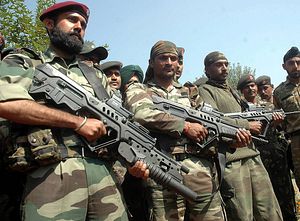Early Thursday morning, India claimed its Special Forces paratroopers crossed the Line of Control in Kashmir, carrying out “surgical strikes” against terrorist camps in Pakistan-occupied Kashmir. India has carried out cross-LoC raids in the past, but what’s notable about Wednesday’s claimed strike, which comes in the aftermath of the Uri attack earlier in September, is wide public messaging regarding the strike. On Thursday, reports of the strike proliferated across the Indian press after a press briefing by Indian Director General-Military Operations (DGMO) Lt. Gen. Ranbir Singh.
Singh, speaking alongside the Indian Ministry of External Affairs’ spokesperson, clarified the nature of the operation:
Based on very credible and specific information which we received yesterday that some terrorist teams had positioned themselves at launch pads along the Line of Control with an aim to carry out infiltration and terrorist strikes in Jammu & Kashmir and in various other metros in our country, the Indian army conducted surgical strikes last night at these launch pads.
Given the inherently furtive nature of special operations, it’s important to note that beyond Singh’s original press conference, little else has been officially released by Indian officials on the record about the strikes. Several Indian sources, nevertheless, have reported on additional details surrounding the strike, citing anonymous senior political and military officials. Singh, in addition to the above, added that “significant casualties have been caused to the terrorists and those who are trying to support them. The operations aimed at neutralizing the terrorists have since ceased. We do not have any plans for continuation of further operations.”
While the what and how of the strikes remain fuzzy in the early hours of reporting, the who and why are more clear in the Indian account. Per Singh’s account, India moved to strike terrorist infrastructure along with “those who are trying to support them”—possibly Pakistani soldiers or elements of the Pakistani state—and justified the strike on the basis of preemptive self-defense against terrorism.
Moreover, seeking to set the record straight with regional states and partners, Delhi has briefed foreign envoys and Indian National Security Adviser Ajit Doval spoke to his U.S. counterpart Susan Rice before the strike. “Ambassador Rice reiterated our expectation that Pakistan take effective action to combat UN-designated terrorist entities, including LeT, JeM, and affiliates,” noted Ned Price, a U.S. National Security Council spokesperson.
Pakistan’s reaction to the strike, meanwhile, has been rather muted. The Inter-Services Public Relations (ISPR), the Pakistani Army’s communications arm, said that “there has been no surgical strike by India,” adding that there had only been “cross border fire.” However, given Delhi’s unusual openness about this cross-LoC strike, Islamabad may be pressured to respond. What remains uncertain at this point is the extent to which Pakistan may choose to escalate in kind, either by increasing the frequency and severity of ceasefire violations along the LoC, potentially leading to a more significant skirmish, or by simply staging a domestic show of force through something like a missile test.
The political and diplomatic context of the strike became clear given the timing as well. Indian held off for ten days after the Uri strike before retaliating, giving an opportunity for Indian Foreign Minister Sushma Swaraj to air Delhi’s grievances in New York at the UN General Assembly. Moreover, as I discussed earlier, Delhi’s tactical diplomatic win with the cancellation of the SAARC summit strengthened India’s regional hand.
On the what and how front, reports continue to conflict regarding whether Indian forces crossed over the LoC by foot or using a low-altitude helicopter approach. Moreover, while there are varying accounts of the depth of Indian penetration across the LoC, most accounts agree that Indian troops did not cross too far across the LoC and struck targets anywhere from 500 meters to 3 kilometers on the Pakistani side.
We’ll be tracking the aftermath of these Indian surgical strikes closely at The Diplomat in the hours and days to come, but a final note on India’s long-standing policy of “strategic restraint.” Singh’s statement and all Indian communication on the strike has emphasized the narrow, tactical, and punitive nature of the strike, saying little else about how Delhi plans to handle the broader strategic issue of suppressing Pakistan’s use of sub-conventional proxies.

































